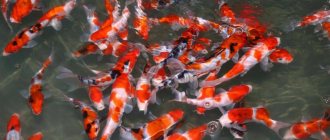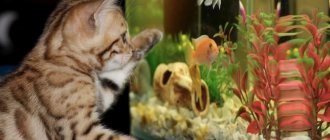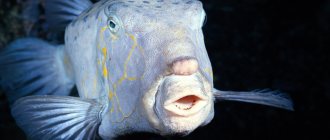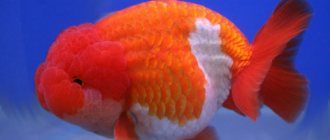One of the most common marine-themed tattoo designs today is the image of a carp. The history of this body design goes back to the countries of the East and, thanks to its numerous variations in execution, is quite popular among representatives of both sexes. Such a demand for a sketch depicting a carp is due to the complete absence of restrictions on the choice of tattoo size. This fact allows body art lovers to turn the most incredible ideas into reality and apply a sketch to any part of the body.
Types of sketches
As we mentioned above, a tattoo with the image of a carp allows you to choose any size, so it can decorate both a small area of the body and be part of a large-scale composition with many details. Carp can be depicted on the crest of a sea wave, against a background of river mud or algae. If earlier it was considered an inconspicuous river fish, today this species is very diverse and sometimes resembles floating gems, which can be used in tattoo design.
Also, very often the fish is complemented by elements of floristry in the form of lotus leaves and flowers, water lilies, peony buds or sakura branches. Sketches can be colorful, monochromatic, or designed in a transition of one color from a dark shade to a lighter one.
Fishing enthusiasts depict a carp caught on a hook. The tattoo is complemented by images of various components of fishing gear. No less rare are body designs that depict a duet of the carp family, designed in the yin-yang style, and body art in a Japanese theme, such as koi carp or designs with hieroglyphs.
Color spectrum
In Japanese culture, the meaning of tattoos varies according to color scheme.
- Red fish represent affection, a deep feeling of love.
- Black reminds us of the path we have taken to success.
- Blue is the embodiment of family and masculinity.
- Gold – good luck and wealth.
- White fish indicate that their owner is building a successful career.
- Black becomes a sign of future pleasant transformations.
Tattoo meaning
The meaning of a tattoo design depicting a carp largely depends on the theme of the sketch and its additions. Drawings designed in oriental style are interpreted only with positive meanings. The Japanese regard carp and its images as a symbol of longevity and prosperity. The Chinese revere this creature as a powerful, wise leader and place him at the head of all fish.
In the modern world, the symbolism of a carp tattoo means willpower, determination, desire for a better life, well-being, the ability to overcome obstacles and helps achieve what you want. Carp is also considered a symbol of good luck, courage, and in many variations it is a talisman for its owner, his motivation for transformation and rebirth.
For men
Initially, the design with a carp was intended only to decorate men's bodies, so tattoos in this style prevail in number and popularity. Carp on a male body emphasizes the independence and perseverance of its owner, and can also symbolize procreation. Men's tattoos with a representative of the carp family can be done in monochrome or in color, at the request of the customer. The owner of such a tattoo sketch is distinguished by his ability to approach solving problems with a cool mind and the ability to always achieve his goal.
Interesting Facts
- Carp are trainable. In Japan, exhibitions are organized where fish are pets and follow commands.
- The oldest carp, Hanako, lived on the planet for 200 years.
- In Japanese culture, fish is a male symbol.
- For geishas, a tattoo serves as proof of the sincerity of feelings.
- Today 14 colors have been confirmed. Unlike goldfish, koi have whiskers on their lower lip.
- Koi are large fish and can reach up to 1 meter in length.
For women
Women's tattoo options are not much different from men's, which undoubtedly makes this design more and more in demand. Images can also be colorful or plain, large or small, contain a duet of fish in a yin-yang composition, or show a single image of a river inhabitant. Most women's tattoo sketches and photos of finished works are complemented by a variety of flowers. In ancient times, representatives of the fair sex preferred to depict a red carp on their bodies. Chaste young ladies chose light pink shades to apply the design. In general, modern carp tattoos serve for women or girls as a symbol of well-being, family happiness and characterize their owner as the ideal keeper of the hearth.
For girls
Young women and girls apply carp as a symbol of family happiness. Pink carp is the color of innocence; fish of a more saturated shade will suit an older woman. The owner of such a tattoo is able to achieve a lot without anyone’s help, on her own. The tattoo looks great around the wrist, on the forearm. It is believed that great luck awaits its owner.
The idea of a tattoo of a pair of fish promises the owner a large family and a rich life. She will probably meet a wealthy betrothed. The sign of Pisces favors prosperity.
Koi carp
With a rich cultural history, the koi carp tattoo has many associations and symbolic meanings. The main meaning is associated with the fish’s ability to overcome currents and climb up waterfalls, which speaks of the courage and perseverance of this creature. Since a tattoo depicting a koi carp has Japanese roots, the interpretation of the sketch largely depends on the choice of color. White Koi - Kohaku, means career success. The combination of white and red symbolizes courage, energy, represents love and the owner’s readiness for a long-term relationship. Kumonryu - a black fish will talk about life changes and transformations. Silver carp or Obon, demonstrates the success of the owner. Golden Koi - Yamabuki, symbolizes prosperity and wealth. A drawing with two fish is the keeper of a strong, happy and long marriage. A sketch in which a koi carp is depicted with the head of a dragon is considered a powerful amulet that can protect the owner from problems and failures.
LiveInternetLiveInternet
Quote from Triinochka's message
Read in full In your quotation book or community!
Figurines of two fish - elite koi carp and arowana fish - are often found in the fashionable feng shui trend. It is believed that the image of these fish in a pair brings wealth and love.
The history of koi carp goes back thousands of years and is described in legends. Its ancestor is considered to be the wild carp. One of the legends says that Japanese farmers who lived high in the mountains, cultivating rice fields, began to raise carp in rice floods in order to provide themselves with fish food in the winter.
According to legend, the first koi carp were white and bright red. Only over time the colors mixed and colored carp appeared. Aesthetic Japanese culture could not ignore the beauty of these magnificent fish. Gradually, koi carp became an indispensable attribute of ponds in the homes of wealthy Japanese. From a fish for food, koi carp has turned into the pride of the nation and the subject of a craze.
Many years of breeding work carried out by the Japanese helped to develop many varieties of these beautiful fish: one-color, two- and three-color. The Japanese carefully kept their secrets and prevented the export of carp from the country.
Of the 80 breeds of koi carp, there are varieties:
Kohaku is a white carp with red or red-orange spots. Taisho Sanshoku is a tri-colored koi with spots on the back. Utsurimono is a black koi carp with a red and yellow pattern. Kin Gin Rin is a very unusual koi whose scales have a metallic sheen. The most popular breed has become the Gosanke, which includes the kohaku and taisho sanshoku species.
It is believed that the very first colored carp was red, then white, and then, as a result of crossing individuals of two colors, red and white beauties appeared
In captivity, koi can live a long time. There are known cases of very decent age - 220 years. Koi carp can grow up to 130 centimeters in length, which is typical for some breeds that are genetically closer to their ancestor, the wild carp. But usually their length does not exceed 90 centimeters. Breeding and keeping koi is finally becoming a more common hobby as koi prices are plummeting due to good supply and selection from different countries.
Artist Terry Gilecki is in love with water and fish. Mixing acrylic with metal powder, working with spray, brushes and engraving elements, he brings to life the beautiful Japanese carp in his creations, which delight the eye with their colors and peace.
The artist was born in 1954 in British Columbia, received a degree in applied art in 1973 and began working
freelance as a commercial artist. His imagination and ability to innovate are recognized as outstanding. Over the course of several years, he began to write independently and widely for international corporations. Along with this activity, he took up the fine arts. With the increase in demand for his work, he realized that he had found his niche and now devotes himself fully to this field.
Captivated by the beauty of koi and the variety of their colors and patterns, he dedicated his artistic creativity to capturing their essence in his masterly paintings. Collectors from all over the world buy these exotic images. While koi are the main feature of his work, the artist also likes to elaborate their surroundings by merging elements above and below the water level, as well as those reflected on its surface.
All paintings used in this article belong to him. I must say, I myself would not refuse such wonderful beauty! Let's move on to the most colorful - his paintings and along the way we will figure out what kind of wonderful fish these are, the image of which attracts the eyes of people from all over the world!
A very interesting video about how a girl feeds a huge school of these fish! 
Where to apply
The main advantage of a tattoo with the image of a carp is its versatility, which allows you to place the sketch on any part of the body and thereby vary the size of the design at your discretion. The most common habitats of carp, which are equally popular among representatives of both sexes, include the back, shoulder blades, chest or arms. Brave young ladies emphasize their individuality by placing the sketch on the hip. It is customary to depict large-scale drawings on the back, reminiscent in appearance of real colorful paintings. Tattoos of this nature are accompanied by many additions and are characterized by maximum detail. To design a tattoo on the arm, it is customary to place the carp in the shoulder or forearm area. Men and young guys often fill their entire arm with an image, designing a tattoo in the form of a sleeve. Compositions in the yin-yang style with a round shape will harmoniously decorate any part of the body. Vertical images look impressive on the sides.
Selection of equipment
When choosing the style of a sketch, you should start from the variation of the drawing itself. Japanese tattoos are performed using the technique of the same name with an abundance of bright colors and thematic additions, for example, hieroglyphs, sakura branches or lotus flowers. Trash polka, which can impress anyone with its originality, looks no less impressive. Tattoos using the realism technique convey the natural characteristics of the fish as much as possible. The Baroque direction will demonstrate the mass character of decorative elements and allow some details of the design to be more clearly expressed. Body drawings in the style of old school, dotwork or watercolor look no less interesting and original.
As you can see, a tattoo depicting a carp can easily be classified as a universal and positive body design. Depending on minor details, the sketch is able to emphasize the individuality of everyone who decides to choose such a sketch. In this example, every lover of body jewelry will be able to find their “goldfish”.











